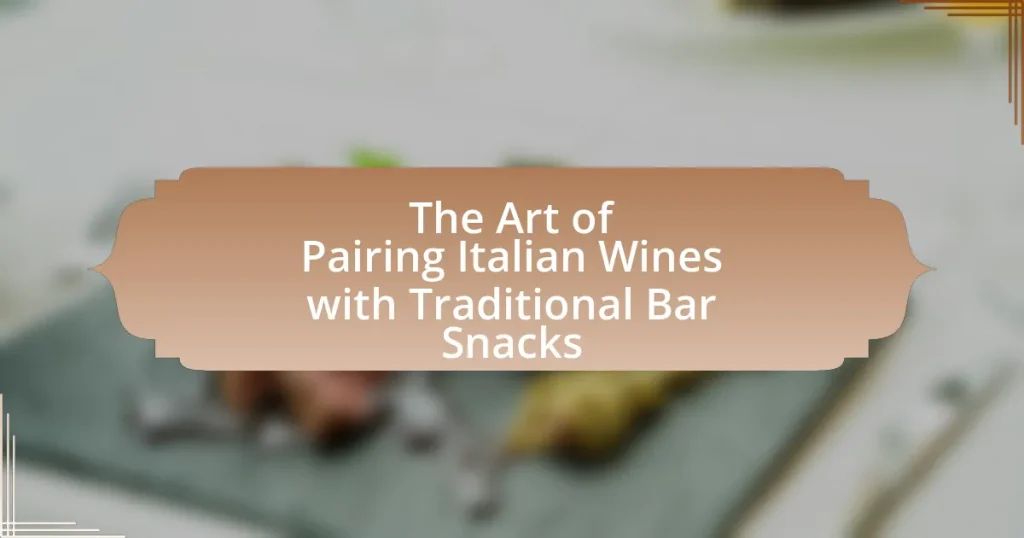The article focuses on the art of pairing Italian wines with traditional bar snacks, emphasizing the significance of flavor and texture complementarity. It explores how various Italian wines, such as Prosecco, Chianti, and Verdicchio, enhance the tasting experience of specific snacks, including olives, cured meats, and fried foods. The article also discusses the influence of regional origins on wine and snack pairings, the basic principles of food and wine pairing, and common mistakes to avoid. Additionally, it provides practical examples of successful pairings and innovative combinations that challenge traditional norms, highlighting the importance of understanding wine characteristics for optimal pairing.

What is the significance of pairing Italian wines with traditional bar snacks?
Pairing Italian wines with traditional bar snacks enhances the overall dining experience by complementing flavors and textures. Italian wines, known for their acidity and complexity, can elevate the taste of salty and savory snacks, creating a harmonious balance. For instance, a crisp Prosecco pairs well with salty olives, while a robust Chianti complements cured meats. This synergy not only highlights the characteristics of both the wine and the snacks but also reflects Italy’s culinary culture, where food and drink are enjoyed together to enhance social interactions.
How do Italian wines enhance the experience of traditional bar snacks?
Italian wines enhance the experience of traditional bar snacks by complementing their flavors and textures, creating a harmonious tasting experience. For instance, a crisp Prosecco can elevate salty snacks like olives or potato chips, as its acidity cuts through the richness, while a robust Chianti pairs well with savory cured meats, enhancing the umami notes. Studies show that wine and food pairing can significantly improve overall enjoyment, as the right wine can accentuate the flavors of the snacks, making them more enjoyable. This synergy between Italian wines and bar snacks is rooted in the culinary traditions of Italy, where wine is an integral part of the dining experience, designed to enhance the enjoyment of food.
What flavor profiles in Italian wines complement specific bar snacks?
Italian wines exhibit diverse flavor profiles that can enhance the enjoyment of specific bar snacks. For example, a crisp Prosecco, with its fruity and floral notes, pairs well with salty snacks like olives and potato chips, as the wine’s acidity balances the saltiness. Chianti, characterized by its cherry and earthy flavors, complements savory snacks such as cured meats and aged cheeses, as the wine’s tannins cut through the richness of these foods. Additionally, a full-bodied Barolo, with its robust structure and complex flavors, matches well with hearty snacks like grilled sausages, as the wine’s depth enhances the umami of the meat. These pairings are supported by the traditional Italian practice of matching local wines with regional foods, which emphasizes the harmony between wine and cuisine.
How does the region of origin influence wine and snack pairings?
The region of origin significantly influences wine and snack pairings by dictating the flavor profiles and traditional culinary practices associated with specific areas. For instance, wines from Tuscany, such as Chianti, are often paired with savory snacks like bruschetta or cured meats, reflecting the region’s rustic cuisine. This pairing is supported by the fact that Tuscan wines typically have high acidity and tannins, which complement the richness of these snacks. Similarly, wines from the Veneto region, like Prosecco, are commonly enjoyed with lighter snacks such as seafood or vegetable antipasti, aligning with the region’s emphasis on fresh, seasonal ingredients. Thus, the geographical and cultural context shapes both the wine characteristics and the complementary snack choices, enhancing the overall tasting experience.
Why is understanding wine and food pairing important?
Understanding wine and food pairing is important because it enhances the overall dining experience by balancing flavors and aromas. When wine complements food, it can elevate the taste of both, creating a harmonious interaction that pleases the palate. Research indicates that certain combinations can enhance the perception of flavors; for example, a study published in the Journal of Sensory Studies found that pairing wine with food can significantly improve the enjoyment of both, as the right wine can amplify the flavors of the dish while minimizing any unpleasant tastes. This knowledge is particularly relevant in the context of Italian wines and traditional bar snacks, where specific pairings can highlight regional characteristics and enhance cultural appreciation.
What are the basic principles of food and wine pairing?
The basic principles of food and wine pairing involve matching the weight, flavor intensity, and acidity of the wine with the characteristics of the food. For instance, a full-bodied red wine complements rich, hearty dishes, while a light white wine pairs well with delicate seafood. Additionally, the acidity in wine can enhance the flavors of food; for example, a high-acid wine can balance fatty foods. These principles are supported by the concept that similar flavor profiles can create harmony, while contrasting elements can provide balance, as seen in classic pairings like Chianti with tomato-based dishes.
How can pairing improve the overall dining experience?
Pairing enhances the overall dining experience by creating harmonious combinations that elevate flavors and textures. When Italian wines are paired with traditional bar snacks, the complementary profiles can intensify the enjoyment of both the food and the beverage. For instance, a crisp Prosecco can enhance the saltiness of fried snacks, while a robust Chianti can balance the richness of cheese. Studies show that well-executed pairings can lead to increased satisfaction and a more memorable meal, as they engage the palate in a more complex tasting experience.

What types of Italian wines are best suited for bar snacks?
Italian wines that are best suited for bar snacks include Prosecco, Chianti, and Verdicchio. Prosecco, a sparkling wine, complements salty snacks like olives and chips due to its acidity and effervescence, which cleanse the palate. Chianti, a red wine, pairs well with cured meats and cheeses, as its tannins balance the richness of these snacks. Verdicchio, a white wine, is ideal for seafood-based bar snacks, as its crispness enhances the flavors of dishes like calamari. These pairings are supported by traditional Italian dining practices that emphasize the harmony between wine and food.
What are the characteristics of popular Italian wine varieties?
Popular Italian wine varieties exhibit distinct characteristics that reflect their regional origins and grape types. For instance, Sangiovese, primarily grown in Tuscany, is known for its high acidity, medium tannins, and flavors of cherry, plum, and earthy notes. Nebbiolo, from the Piedmont region, is characterized by its robust tannins, high acidity, and complex aromas of rose, tar, and red fruit. Barbera, also from Piedmont, offers lower tannins, higher acidity, and flavors of cherry and blackberry, making it versatile for food pairing. Pinot Grigio, predominantly from the Veneto region, is light-bodied with crisp acidity and notes of green apple and pear, ideal for seafood dishes. Lastly, Prosecco, a sparkling wine from Veneto, is known for its fruity and floral aromas, with a refreshing effervescence, making it a popular choice for aperitifs. These characteristics not only define the wines but also influence their compatibility with traditional bar snacks, enhancing the overall dining experience.
How do red wines differ from white wines in pairing with snacks?
Red wines differ from white wines in pairing with snacks primarily due to their flavor profiles and tannin structures. Red wines, which often have bolder flavors and higher tannin content, pair well with heartier snacks such as cured meats, aged cheeses, and savory dishes, as the tannins can complement the richness of these foods. In contrast, white wines, typically lighter and crisper, are better suited for lighter snacks like seafood, fresh vegetables, and creamy cheeses, as their acidity can enhance the freshness of these items. This distinction is supported by the general principle of pairing wines with foods that match their weight and intensity, ensuring a balanced tasting experience.
What role do sparkling wines play in bar snack pairings?
Sparkling wines enhance bar snack pairings by providing a refreshing contrast to salty and savory flavors. The effervescence in sparkling wines, such as Prosecco or Franciacorta, cuts through rich snacks like fried calamari or cheese platters, balancing the palate. Additionally, the acidity in these wines complements the umami in snacks like olives and cured meats, making them more enjoyable. Studies show that the carbonation in sparkling wines can elevate the overall tasting experience, as it stimulates the senses and enhances flavor perception.
Which Italian wines are recommended for specific traditional bar snacks?
Prosecco is recommended for pairing with traditional Italian bar snacks such as olives and bruschetta. The wine’s crisp acidity and fruity notes complement the saltiness of olives and the freshness of tomatoes on bruschetta. Chianti, with its medium body and tannins, pairs well with cured meats like prosciutto and salami, enhancing the savory flavors. For fried snacks like arancini, a light and refreshing Pinot Grigio is ideal, as its acidity cuts through the richness of the fried coating. These pairings are based on the traditional Italian practice of matching the wine’s characteristics with the flavors and textures of the snacks, ensuring a harmonious dining experience.
What wines pair well with olives and nuts?
Wines that pair well with olives and nuts include dry white wines like Verdicchio and Sauvignon Blanc, as well as light-bodied red wines such as Pinot Noir and Chianti. These wines complement the salty and savory flavors of olives and the rich, earthy notes of nuts. For instance, Verdicchio’s crisp acidity balances the brininess of olives, while Chianti’s acidity and tannins enhance the nutty flavors. Studies in wine pairing suggest that acidity and flavor intensity are key factors in successful combinations, making these wines ideal choices for enhancing the tasting experience with olives and nuts.
How do wines complement fried snacks like arancini or calamari?
Wines complement fried snacks like arancini or calamari by enhancing their flavors and balancing their richness. The acidity in wines, such as a crisp white like Pinot Grigio or a sparkling wine like Prosecco, cuts through the oiliness of fried foods, providing a refreshing contrast. Additionally, the fruity and herbal notes in these wines can elevate the savory elements of the snacks, creating a harmonious tasting experience. Studies have shown that pairing acidic wines with fried foods can enhance overall palate satisfaction, making the combination more enjoyable.

How can one effectively pair Italian wines with traditional bar snacks?
To effectively pair Italian wines with traditional bar snacks, one should consider the flavor profiles of both the wine and the snacks. For example, a crisp Prosecco complements salty snacks like olives or potato chips, while a robust Chianti pairs well with savory meats such as salami or prosciutto. This pairing strategy is supported by the principle that acidity in wine balances the saltiness of snacks, enhancing the overall tasting experience.
What tips can enhance the pairing process?
To enhance the pairing process of Italian wines with traditional bar snacks, focus on balancing flavors and textures. For instance, pairing a crisp Prosecco with salty snacks like olives or nuts creates a refreshing contrast that elevates both the wine and the food. Additionally, consider the regional compatibility; pairing wines from specific Italian regions with corresponding local snacks can enhance authenticity and flavor harmony. Research indicates that matching acidity levels in wine with the saltiness of snacks can significantly improve the overall tasting experience, as demonstrated in studies on flavor interactions in food and wine pairings.
How should one approach the tasting process for optimal pairing?
To approach the tasting process for optimal pairing, one should begin by assessing the characteristics of both the wine and the snack. This involves evaluating the wine’s acidity, sweetness, tannins, and body, alongside the snack’s flavor profile, texture, and saltiness. For instance, a high-acid wine like a Chianti complements salty snacks such as olives or cured meats, enhancing the overall tasting experience. Research indicates that complementary flavors and contrasting textures can elevate the enjoyment of both the wine and the food, as supported by studies in sensory analysis that highlight the importance of balance in flavor profiles.
What common mistakes should be avoided when pairing?
Common mistakes to avoid when pairing Italian wines with traditional bar snacks include ignoring the flavor profiles of both the wine and the food, which can lead to mismatched tastes. For instance, pairing a robust red wine with delicate seafood can overwhelm the dish, while a light white wine may not complement a rich, savory snack. Additionally, neglecting the acidity and sweetness levels can result in an unbalanced pairing; a high-acid wine can enhance salty snacks, while a sweet wine can clash with bitter flavors. Lastly, failing to consider the regional compatibility of the wine and snack can diminish the overall experience, as traditional pairings often reflect local culinary practices.
What are some practical examples of successful pairings?
Successful pairings of Italian wines with traditional bar snacks include Prosecco with olives, Chianti with bruschetta, and Barolo with aged cheeses. Prosecco’s effervescence complements the saltiness of olives, enhancing the overall flavor experience. Chianti, with its acidity and fruitiness, pairs well with the fresh tomatoes and basil in bruschetta, creating a balanced taste. Barolo, known for its robust tannins, matches the richness of aged cheeses, allowing the wine’s complexity to shine. These pairings are widely recognized in Italian culinary traditions, demonstrating their effectiveness in enhancing both the wine and snack flavors.
How can one create a balanced wine and snack menu for gatherings?
To create a balanced wine and snack menu for gatherings, one should select wines that complement the flavors of the snacks while considering the overall taste experience. For instance, pairing a light, crisp Italian white wine like Pinot Grigio with salty snacks such as olives or cheese enhances the palate. Conversely, a robust red wine like Chianti pairs well with heartier snacks like cured meats or savory pastries, creating a harmonious balance. Research indicates that matching the acidity and body of the wine with the richness of the food leads to a more enjoyable tasting experience, as supported by studies on flavor pairing principles.
What are some innovative pairings that challenge traditional norms?
Innovative pairings that challenge traditional norms include the combination of Prosecco with spicy nachos and Chianti with dark chocolate. Prosecco, a sparkling wine, enhances the heat of spicy nachos, creating a refreshing contrast that is not commonly explored. Chianti, typically paired with savory dishes, complements the bitterness of dark chocolate, offering a unique flavor experience that defies conventional wine and snack pairings. These combinations illustrate how Italian wines can be creatively matched with unexpected snacks, expanding the palate and redefining traditional pairings.










